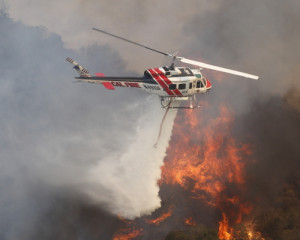How to Prepare Your Home for the Wildfire Season

Wildfire season starts in late spring, extends into late fall and causes billions of dollars in damage every year.
As we move into wildfire season we thought it would be helpful to look at how you can prepare your home and property to defend against wildfire damage. Wildfire season starts in late spring, extends into late fall and causes billions of dollars in damage every year. Properly preparing your house can mean the difference between a near miss and watching helplessly as your home burns to the ground.
Where you live matters. All of the top ten states that carry a very high risk designation for wildfire damage are located west of the Mississippi and the closer your are to a forest, the higher the risk. According to a recent report, there are roughly 1.2 million home in the west that are at risk for being damaged or destroyed by wildfires.
CoreLogic put out a Wildfire Hazard Risk Report in 2013 that rates the top 10 states considered to be at a very high risk for wildfire damage. The value of the homes that fall in to this category comes in at $189 billion. Here is a quick rundown of the top 10 and the number of homes in high-risk areas.
- Texas – 678,544 homes
- California – 375,500 homes
- Colorado – 200,443 homes
- Oregon – 107,388 homes
- Arizona – 48,823 homes
- New Mexico – 35,024 homes
- Montana – 26,468 homes
- Utah – 22,859 homes
- Idaho – 22,503 homes
- Nevada – 11,698 homes
The report went even further, drilling down to cities that have a large concentration of homes at risk for wildfire damage. Los Angeles topped the list with over 60,000 homes valued at 8.3 billion in the danger zone. Recent fire seasons have proved that damage or destruction by wildfire is a very real concern. Part of the problem is the dramatic growth in homes located in wilderness and forested areas.
Preparing Your Home Against Wildfires
The first, and most important thing to do is create a defensible space around your home. Creating a buffer zone around your property can help prevent fire from reaching your property. Many states have space requirements for homes in wildfire risk areas. As an example, California requires a 100-foot buffer zone from any buildings.
This means that all dead plants and brush must be removed as well as any woodpiles and fallen pine needles. It is also recommended that grass should be mowed to 4 inches or less. Trees and shrubs should be spaced at a safe distance apart from each other.
When building or remodeling, protect your home by using non-combustible materials. Using composition, metal or tile to cover your roof instead of wood shingles can make your home more fire-resistant. You should also cover chimney outlets, vent openings and stovepipes with mesh. It is also a good idea to enclose your gutters to prevent plants and leaves from accumulating and becoming a fire hazard.
Landscaping is another area where proper planning can help make your home and property less fire prone. Use fire-resistant plants such as roses, cotoneaster, sumac and shrub apples. Hardwood trees are also less flammable than others. Consider cherry, popular, and maple over pine and fir trees.
Being fire wise on your property can also make a huge difference in the event a fire starts on your property or is headed your way. Be sure your road and house number is clearly marked, the sooner the fire department can get to your property the better chance your home will be saved. Have an emergency water supply and be able to access it quickly in the event of an emergency. Experts recommend having a minimum water storage supply of 2,500 gallons.
Consider having a sprinkler system installed in your home and be sure there are fire extinguishers strategically placed around the house. Have an escape plan in place and make sure you practice it on regular basis with your family.
Make Sure You have Enough Insurance
If you end up being a victim of a fire you want to be sure that you have enough insurance to rebuild your home. The home insurance agents of HomeInsuranceKing.com would like to advise homeowners to carry enough coverage to completely rebuild your home and replace all of your belongings. Advise your insurer of any upgrades you make to the house or if you finish off additional square footage, such as a basement.
Upgrades and remodeling will add value to your home that may not be covered if you do not update your policy and coverage levels. A complete home inventory is also a must to ensure that you are reimbursed for all of your possessions that are lost in a fire.
